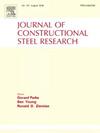Optimization method of space grid structure considering the coupling effect of multiple loads, grid topology, and pole section
IF 4
2区 工程技术
Q1 CONSTRUCTION & BUILDING TECHNOLOGY
引用次数: 0
Abstract
Given the limitations of the traditional phased design method, this paper proposes an integrated selection and optimization method that considers both the grid topology and the pole section design. The proposed method can consider the influence of structural topology and pole dimensions and the influence of multiple working conditions and their combinations according to the specifications, ensuring that the optimized solution meets the actual engineering requirements. This paper presents the mathematical model, objective function, constraints, and program implementation process of the method. The method uses the minimum amount of steel to determine the optimal grid topology and pole section size. The proposed elite strategy genetic algorithm enables fast selection and global optimisation of structural solutions. The algorithm shows that the method proposed in this paper has high solution accuracy and efficiency, and the optimized grid topology solution uses significantly less steel, which fully illustrates the rationality of this method. The optimisation methodology and the optimisation program proposed in this paper can facilitate the rapid design of grid structures and reduce the cost-effectively.
求助全文
约1分钟内获得全文
求助全文
来源期刊

Journal of Constructional Steel Research
工程技术-工程:土木
CiteScore
7.90
自引率
19.50%
发文量
550
审稿时长
46 days
期刊介绍:
The Journal of Constructional Steel Research provides an international forum for the presentation and discussion of the latest developments in structural steel research and their applications. It is aimed not only at researchers but also at those likely to be most affected by research results, i.e. designers and fabricators. Original papers of a high standard dealing with all aspects of steel research including theoretical and experimental research on elements, assemblages, connection and material properties are considered for publication.
 求助内容:
求助内容: 应助结果提醒方式:
应助结果提醒方式:


